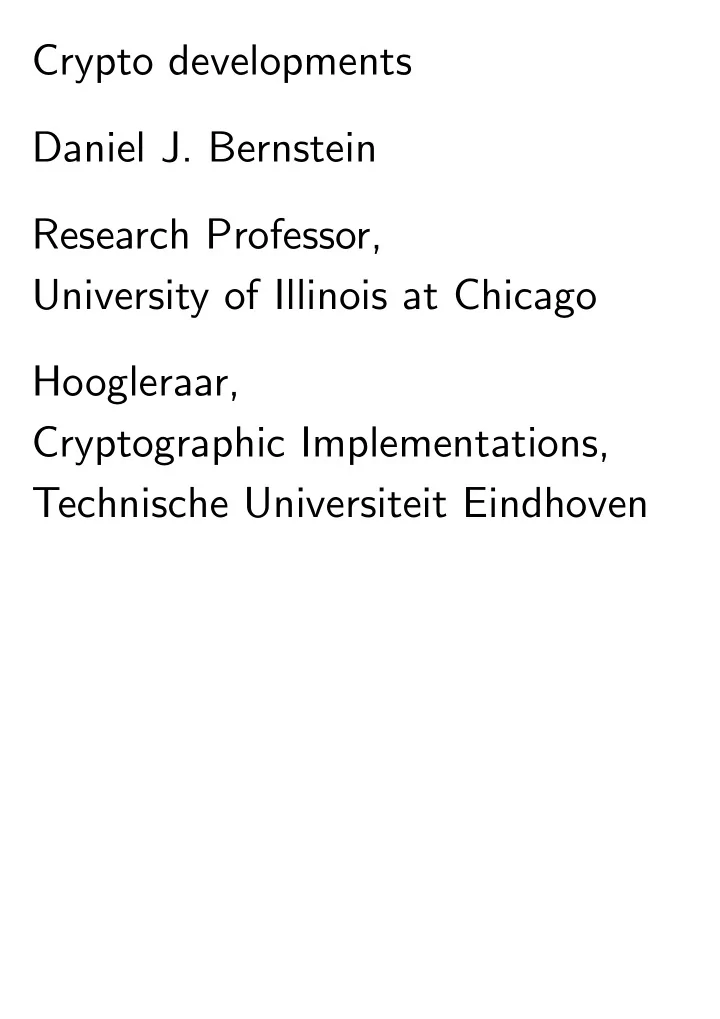

Crypto developments Daniel J. Bernstein Research Professor, University of Illinois at Chicago Hoogleraar, Cryptographic Implementations, Technische Universiteit Eindhoven
A bit about me Designer of: • qmail , used by Yahoo to handle Internet mail; • tinydns , used by Facebook to publish server addresses; • dnscache , used by OpenDNS to look up server addresses; • Curve25519 public-key system used by Apple to protect files stored on iPhones; • ChaCha20 secret-key cipher used by Chrome to encrypt HTTPS connections to Google.
Standard crypto is failing Goals: protect confidentiality, integrity, and availability.
Standard crypto is failing Goals: protect confidentiality, integrity, and availability. Standard crypto does a bad job of meeting these goals today, and an even worse job tomorrow.
Standard crypto is failing Goals: protect confidentiality, integrity, and availability. Standard crypto does a bad job of meeting these goals today, and an even worse job tomorrow. The standardization process does not insist on security; ignores important warnings from cryptographers; ignores predictable improvements in computer technology; and is unable to resist attack.
MD5 2008 Stevens–Sotirov– Appelbaum–Lenstra–Molnar– Osvik–de Weger exploited MD5 ⇒ rogue CA for TLS.
MD5 2008 Stevens–Sotirov– Appelbaum–Lenstra–Molnar– Osvik–de Weger exploited MD5 ⇒ rogue CA for TLS. 2012 Flame: new MD5 attack.
MD5 2008 Stevens–Sotirov– Appelbaum–Lenstra–Molnar– Osvik–de Weger exploited MD5 ⇒ rogue CA for TLS. 2012 Flame: new MD5 attack. Fact: By 1996, a few years after the introduction of MD5, Preneel and Dobbertin were calling for MD5 to be scrapped.
MD5 2008 Stevens–Sotirov– Appelbaum–Lenstra–Molnar– Osvik–de Weger exploited MD5 ⇒ rogue CA for TLS. 2012 Flame: new MD5 attack. Fact: By 1996, a few years after the introduction of MD5, Preneel and Dobbertin were calling for MD5 to be scrapped. Internet crypto standardization continued using MD5.
Taiwan Citizen Digital Certificates Renesas HD65145C1 “High- Security Microcontroller”: tested by T-Systems, certified by BSI at CC assurance level EAL4+.
Taiwan Citizen Digital Certificates Renesas HD65145C1 “High- Security Microcontroller”: tested by T-Systems, certified by BSI at CC assurance level EAL4+. Used in Chunghwa Telecom HICOS PKI Smart Card, tested by DOMUS IT Security Laboratory, FIPS 140-2 Level 2 certificate jointly from NIST and CSE.
Taiwan Citizen Digital Certificates Renesas HD65145C1 “High- Security Microcontroller”: tested by T-Systems, certified by BSI at CC assurance level EAL4+. Used in Chunghwa Telecom HICOS PKI Smart Card, tested by DOMUS IT Security Laboratory, FIPS 140-2 Level 2 certificate jointly from NIST and CSE. Deployed for two million people.
Taiwan Citizen Digital Certificates Renesas HD65145C1 “High- Security Microcontroller”: tested by T-Systems, certified by BSI at CC assurance level EAL4+. Used in Chunghwa Telecom HICOS PKI Smart Card, tested by DOMUS IT Security Laboratory, FIPS 140-2 Level 2 certificate jointly from NIST and CSE. Deployed for two million people. 2013 Bernstein–Chang–Cheng– Chou–Heninger–Lange–van Someren: 184 keys factored.
Dual EC 2004: ANSI draft “Dual EC” random-number generator. (Didn’t say: designed by NSA, secretly predictable to NSA.)
Dual EC 2004: ANSI draft “Dual EC” random-number generator. (Didn’t say: designed by NSA, secretly predictable to NSA.) 2006 Gjøsteen: Dual EC is biased. 2006 Sidorenko–Schoenmakers: Dual EC is even more biased.
Dual EC 2004: ANSI draft “Dual EC” random-number generator. (Didn’t say: designed by NSA, secretly predictable to NSA.) 2006 Gjøsteen: Dual EC is biased. 2006 Sidorenko–Schoenmakers: Dual EC is even more biased. NIST then standardized Dual EC.
Dual EC 2004: ANSI draft “Dual EC” random-number generator. (Didn’t say: designed by NSA, secretly predictable to NSA.) 2006 Gjøsteen: Dual EC is biased. 2006 Sidorenko–Schoenmakers: Dual EC is even more biased. NIST then standardized Dual EC. 2007 Shumow–Ferguson: would have been easy to make Dual EC secretly predictable.
Dual EC 2004: ANSI draft “Dual EC” random-number generator. (Didn’t say: designed by NSA, secretly predictable to NSA.) 2006 Gjøsteen: Dual EC is biased. 2006 Sidorenko–Schoenmakers: Dual EC is even more biased. NIST then standardized Dual EC. 2007 Shumow–Ferguson: would have been easy to make Dual EC secretly predictable. NIST kept standard until 2014.
Heartbleed Crypto standardization process rewards unnecessary complexity.
Heartbleed Crypto standardization process rewards unnecessary complexity. Exception: small platforms. But modern crypto platforms are complicated software devices.
Heartbleed Crypto standardization process rewards unnecessary complexity. Exception: small platforms. But modern crypto platforms are complicated software devices. Complex crypto is practically impossible to get right and audit. Many security holes: Heartbleed, goto fail, new SChannel bug, etc.
Heartbleed Crypto standardization process rewards unnecessary complexity. Exception: small platforms. But modern crypto platforms are complicated software devices. Complex crypto is practically impossible to get right and audit. Many security holes: Heartbleed, goto fail, new SChannel bug, etc. Crypto is front line, performance-constrained. Hard to isolate and monitor.
Quantum computers Attacker equipped with a large Shor computer breaks RSA, DSA, ECDSA, ECDH, etc.
Quantum computers Attacker equipped with a large Shor computer breaks RSA, DSA, ECDSA, ECDH, etc. Retroactively decrypts intercepted ciphertexts, whether or not they have “perfect forward secrecy”.
Quantum computers Attacker equipped with a large Shor computer breaks RSA, DSA, ECDSA, ECDH, etc. Retroactively decrypts intercepted ciphertexts, whether or not they have “perfect forward secrecy”. No evidence that attackers have a Shor computer today. (D-Wave computer seems to be quantum but isn’t Shor.)
Quantum computers Attacker equipped with a large Shor computer breaks RSA, DSA, ECDSA, ECDH, etc. Retroactively decrypts intercepted ciphertexts, whether or not they have “perfect forward secrecy”. No evidence that attackers have a Shor computer today. (D-Wave computer seems to be quantum but isn’t Shor.) My probability assessment: Medium probability by 2025. High probability by 2030.
Recommend
More recommend